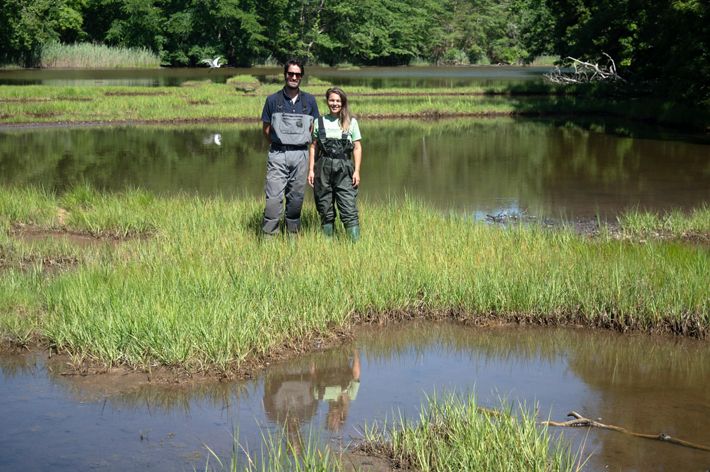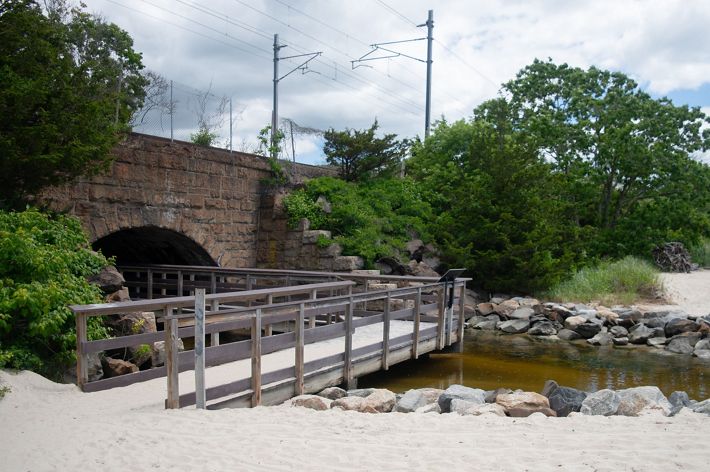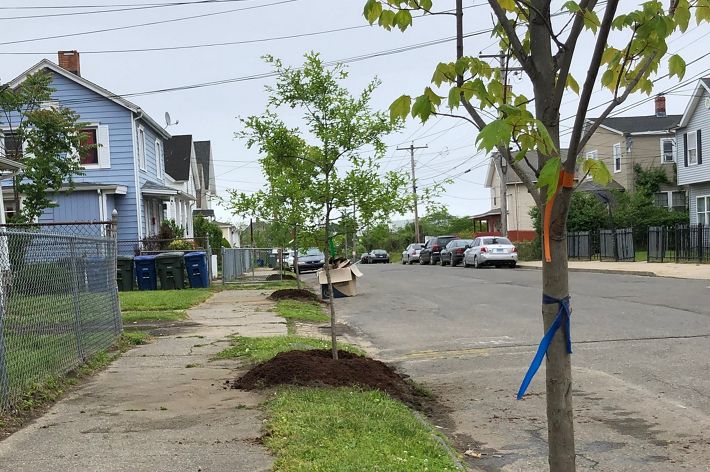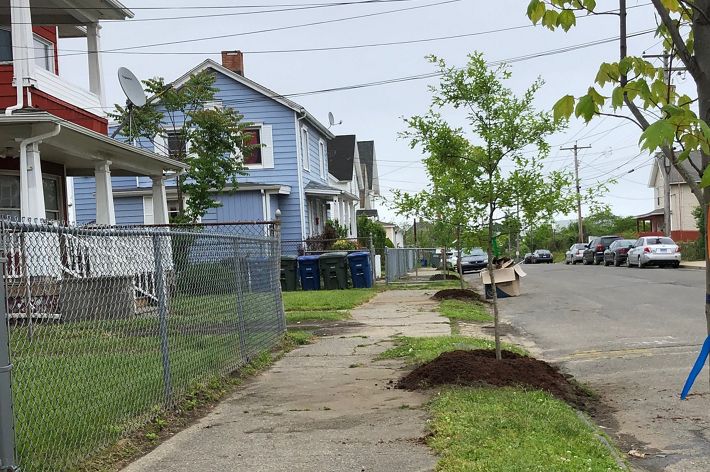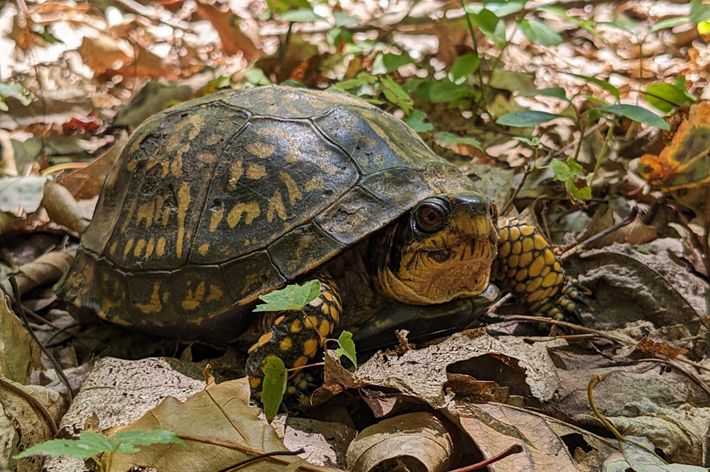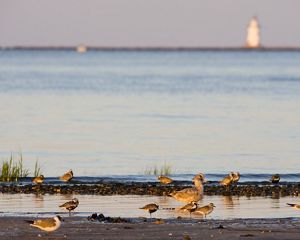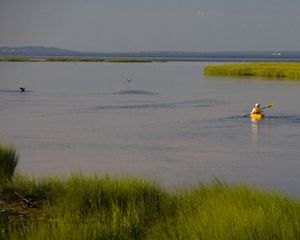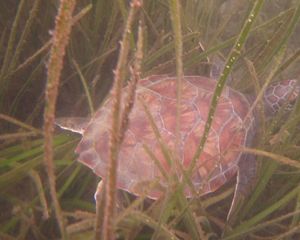
Connecticut Annual Report
Thanks to your support, we accomplished so much in 2024.

From the Director
We are pleased to share this year’s Annual Report. Nature needs you and all of us. Dr. Frogard Ryan, The Nature Conservancy's state director in Connecticut, and Bola Olusanya, TNC’s vice president and chief investment officer, reflected on 2024’s many wins and challenges. Here is a glimpse of their conversation.
FROGARD: What a year it’s been, for TNC and for nature. How are you feeling?
BOLA: I’m always thinking about how much work we have to do. It is truly life-changing for people and our planet. But I’m hopeful and excited when I learn about a new community partner joining a project, or ways we’re co-managing land with Indigenous Peoples, or a reconnected river welcoming more migratory fish. How have things been in Connecticut?
FROGARD: We’ve been working heavily on community resilience and climate legislation, which has been especially urgent as we watch extreme weather ramp up—you may have seen Connecticut flooding on national news this summer when streams turned into rushing rivers during a 15-inch rainfall in the western part of the state.
BOLA: I did see that. It’s the kind of story we hear from TNC chapters in the United States and across the globe. TNC is in more than 80 countries, which all have unique needs, but we see two big crises everywhere: biodiversity loss and climate change. For so many, the problems are scary and feel too big to tackle. But they are enormous signs that nature needs us—and that we can’t wait. That’s why TNC is working harder than ever.
FROGARD: What I’m always reminded of is that nature knows no state lines, no boundaries of any kind. I take comfort in knowing that what we do at home in Connecticut ripples across New England and beyond. We’re doing work for our local land and communities, but it makes double the difference because that impact travels.
BOLA: On my team, that’s exactly how we feel. We need to include more people in this dialogue, while finding innovative methods and investments to deploy nature-based solutions. When I must dig deep for inspiration, I think back to my trip to Rwanda—spending time in a local community and seeing the crises of biodiversity and climate through their eyes, especially the youngsters. Geographically, they’re continents away, but we’re bonded through our shared efforts. Nature is healing, for us humans and for its own challenges. We need to harness that power.
FROGARD: I’m so excited about how we’re doing that at home in Connecticut and the ways we will reach big goals for our planet across TNC. So much went on in 2024, and we hope to show everyone that nature needs you—and that change happens when we connect and work together.
Quote: Bola Olusanya
THERE'S SOMETHING IN THE WATER
Rocky Neck State Park
For the salt marsh at Rocky Neck State Park, things have been…rocky. The area is known for its stunning beach, train route, peaceful walking paths and pavilion, but the marsh is a large and integral piece of the ecosystem. It’s about to get some much needed support through a $4 million grant secured by The Nature Conservancy from the National Oceanic and Atmospheric Administration (NOAA).
Specifically, TNC will manage the Bride Brook Estuary Transformation Project in collaboration with the Connecticut Department of Energy and Environmental Protection, which manages the park, and local partners. A team has launched a planning process for transformative work to restore the Bride Brook estuary and coastal marsh at Rocky Neck; ensure resilience; and improve visitor access to the park’s natural resources.
Farmington River
Ranked 6th on the 2024 Most Endangered Rivers list for the United States due to concerns for fish and the local ecosystem, the health of Connecticut's Farmington River is connected to a local dam. What can be done about dams and culverts that render waterways non-navigable for migrating fish? The Nature Conservancy is creating solutions to reconnect and support rivers, like the Farmington River.
Support is growing. More than 100 people attended TNC's first-ever World Fish Migration Day event in May. Guests hiked along the Farmington River, learned about local organizations and joint efforts to reconnect rivers and enjoyed a documentary screening on river restoration—particularly how the removal of obsolete and vulnerable dams can renew an ecosystem and open wildlife passageways.
Only 1/3 of the world’s longest rivers remain free-flowing. Freshwater plants and animals have declined by 83% since 1970. TNC is working to safeguard or restore 1 million+ kilometers of healthy rivers and streams by 2030. In Connecticut, our efforts toward that goal will involve the Town of Groton where we are partnering to improve a culvert along Haley Brook, a tributary of the Mystic River. A new design would facilitate fish passage for critical migratory species like river herring and brook trout, with a more resilient crossing during extreme storm events and flooding.
Quote: Emily Hadzopulos
We hope that as more people understand the immense value of reconnecting rivers, we’ll see additional support for these efforts. Nature-based solutions bring positive outcomes very quickly in a local area, but also create a ripple effect.
GOING OUT ON A LIMB
Urban Forestry
The power of a tree…Huge, if you think about it. Shade, oxygen, cooling effects, a home for wildlife, a filter for air and water, a tool for sequestering carbon, the backdrop to childhood memories. That’s why protecting trees is more urgent than ever, especially in the face of a rapidly changing climate.
Through that work, The Nature Conservancy secured a $2.2 million grant to establish the Connecticut Urban Forest Network for Equity and Resilience. Funding comes via the U.S. Forest Service’s Urban and Community Forestry Program and Inflation Reduction Act. The network aims to build the state’s urban forestry capacity, particularly in communities with very low tree canopy, and support more urban forest advocates and practitioners.
Nature needs healthy trees—the signs were clear as extreme heat ran on repeat all summer. The heat island effect made it more intense in cities (when temperatures are higher due to buildings, pavement and parking lots).
The seeds were planted years ago, in more ways than one, when TNC’s urban forestry work began in Bridgeport. Now, efforts are reaching statewide as a nature-based solution to tackle effects of climate change.
Quote: Drew Goldsman
There are numerous approaches to caring for and expanding Connecticut’s urban forests, and many communities seek opportunities to learn from their peers. Time is of the essence, and bringing together communities across the entire state will maximize impact.
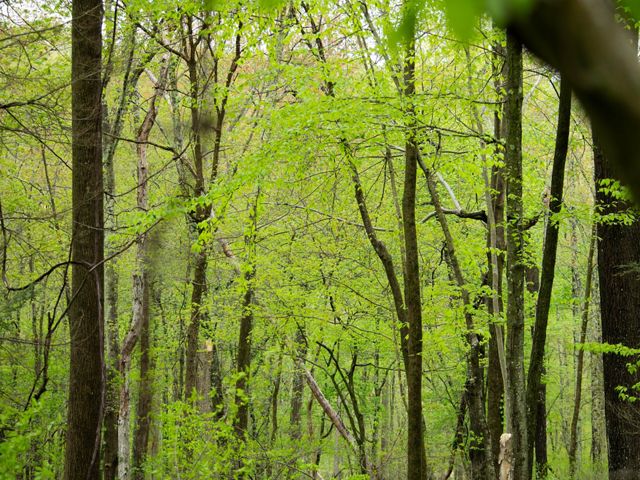
WHAT'S HAPPENING?
Pests and disease attack trees Gaps emerge in the forest canopy Fewer native species thrive Invasive species grow unchecked Reducing native biodiversity and resilience across entire forests.
How can we fix it?
- Research
- Breeding with resistant survivor trees
- Cultivating successful saplings
- Years and years of patience
Tree Species in Peril Project
Imagine a future where Connecticut forests have lost some of their most recognizable, magnificent and essential native trees—American beech, Eastern hemlock and ash. Invaded and decimated by pests and disease over decades, these native species are dying out, triggering a cascade of negative consequences beyond the loss of trees themselves. They need people like you, who understand their immense value, as well as scientists and researchers, to join together for solutions.
Luckily, that’s happening through the Tree Species in Peril project, made possible by the Manton Foundation, which The Nature Conservancy has proudly called a partner for the last decade. Species under greatest threat could one day be eliminated from diverse forest ecosystems, in Connecticut and across the country, from New England to the Midwest. So, since 2022, TNC has been rapidly coordinating efforts, alongside our primary partner, the U.S. Forest Service, to disrupt this destructive chain of events. The blueprint will be used to rapidly respond to future pests, diseases and climate challenges, keeping our forests healthy and diverse. Tree Species in Peril is a critical investment in the future of North American forests—because our work here matters everywhere.
PLACES WE PROTECT
TNC's 50+ nature preserves are beautiful places. They are also:
- Habitats that are home to diverse native animal and plant species
- Natural areas that capture carbon and build climate resilience
- Refuge for connecting with nature
Nature has to be accessible for people of all ages and abilities. TNC is working to help everyone find new ways to connect with nature at TNC's Connecticut preserves.
RESILIENT COMMUNITIES
Community Resilience Process
When TNC leads its Community Resilience Building (CRB) process with a municipality or academic institution, the work doesn’t stop there. It’s truly just the beginning. The city of Stamford is seeing that firsthand.
Back in 2013, Stamford asked TNC, in partnership with the Western Connecticut Council of Governments, to initiate its very own CRB process. Goals included helping the city become more resilient, sustainable and equitable.
With 40+ participants representing 25+ organizations, the process led to agreement on climate action plans with a list of priority actions. One in particular provided TNC with an opportunity to help Stamford’s Stormwater Management Department reduce flooding impacts and decrease stress that runoff from storms can place on municipal sewer systems and streams and rivers at the end of the pipes. The goal was to generate flood reduction and water quality improvement by installing green stormwater infrastructure projects (like bioswales, tree street planting, green roofs, rainwater harvesting, porous pavement and other bioengineering techniques).
In the following years, TNC worked to secure funding and allowances to design and install Stamford’s first bioswale in 2019. The location was sited in the downtown business district directly in front of the University of Connecticut Stamford Campus in hopes of educating residents and students on green stormwater infrastructure practices. Dr. Adam Whelchel, TNC's director of science in Connecticut, worked with a contractor to install the bioswale—a success that resulted in Whelchel and TNC receiving the highest environmental honor that the city awards.
The project’s importance and impact were clear. So clear, that Tyler Theder, Stamford’s director of stormwater management, decided the city would be better off with more bioswales. Stamford is now installing 20 additional bioswales with $1M in Congressionally directed funding.
From providing a CRB, to identifying green stormwater infrastructure as a priority, to partnering on installation and offering continued expertise, TNC is proud to have served as a catalyst for this work. In building strong partnership, and prioritizing nature-based solutions, the effort will help reduce climate impacts in one of Connecticut’s biggest cities—while being a model for others anywhere in the state.
Quote: Caroline B. Simmons
Bioswales fit in with a larger goal to make Stamford more resilient and sustainable, while also adding to the aesthetics of sidewalks with plantings and some greenery.
Capitol Projects
The clock struck midnight on a May evening, ending the year’s legislative session in Hartford. It had been an especially busy season for TNC, from crafting bills and testifying in support, to meeting with legislators. Multiple TNC-supported bills were victorious:
- Legislation allowing the state’s Department of Energy and Environmental Protection more authority to shut down dams deemed unsafe or dangerous.
- An act supporting solar, including solar canopies and a provisional lift of a solar cap.
- A bill allowing a 30-year contract option for offshore wind (OSW) power, which can help enable OSW deployment.
The session’s end won’t stop TNC from again advocating for a climate omnibus bill that did not come up for a Senate vote, but passed the House of Representatives. When the new session begins, we’ll build on that momentum.
Realizing a Vision
TNC has worked extensively with the City of Groton, including the development of the Southeastern Connecticut Regional Framework for Coastal Resilience. Next up: addressing longstanding issues from stormwater flooding in the Five Corners neighborhood by assessing affected areas and developing nature-based solutions. Infrastructure is being pushed beyond limits by the volume of water in the area.
TNC will work with community partners, businesses in the area and designers to envision a resilient Five Corners neighborhood. Once the City of Groton’s stormwater assessment is complete, the community can seek implementation funding and address life-threatening flooding.
BIODIVERSITY
Harmony For Highways and Habitats
Connecticut is a unique mosaic of habitats, with connections between tidal and river environments, and forest, grassland and wetlands. It all contributes to diverse wildlife: 84 species of mammals, 335 bird species, 50 species of reptiles and amphibians, 169 fish species and around 20,000 species of invertebrates.
It also means wildlife is out and about near people—and vehicles. TNC is enhancing safety for all of the above. In partnership with the Connecticut Department of Transportation and Department of Energy and Environmental Protection, and supported by funding secured through the Federal Highway Administration’s Wildlife Crossing Pilot Program, TNC is leading a joint project to evaluate and protect movement of people and wildlife. The expected results? A mapping toolset for state decisions on infrastructure and environmental projects, and, over time, fewer wildlife-vehicle collisions and increased habitat connectivity. That means a safer home for people and animals.
Habitat fragmentation and loss are the greatest threat to Connecticut’s biodiversity. An average of 1,028 deer collisions occurred annually here from 2015-2022. Work will identify critical habitat blocks, and roads intersecting such blocks and migratory corridors.
Mapping the Future for Migratory Species
You could say the Appalachian Mountains are like a highway for wildlife, crossing 19 states, and yes, that includes Connecticut—up in our northwest corner! As climate change drives ecosystem instability, plants and animals are shifting northward and upslope. They need connected lands like the Appalachians to provide safe passage and a thriving home. Through TNC’s Resilient and Connected Appalachians Grant Program, two Connecticut land trusts received grants to conserve parcels in the mountain range.
TNC awarded $50,000 each to the Norfolk Land Trust and the Warren Land Trust, creating a contiguous protected block of approximately 1,200 acres when combined with additional lands. A stronghold of climate resilience and vital migration pathway for diverse species, the Appalachian range is a focal point for protection efforts. Indeed, a virtual superhighway for nature will be stitched together.
View the Full Report
-
2024 Annual Report
A look at highlights and conservation successes across Connecticut during 2024.
Download
We Can’t Save Nature Without You
Sign up to receive monthly conservation news and updates from Connecticut.

